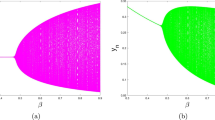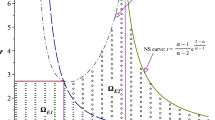Abstract
In this paper, we study a delayed diffusive predator–prey model with nonlocal competition in prey and habitat complexity. The local stability of coexisting equilibrium is studied by analyzing the eigenvalue spectrum. Time delay inducing Hopf bifurcation is investigated by using time delay as bifurcation parameter. We give some conditions for determining the bifurcation direction and the stability of the bifurcating periodic solution by utilizing the normal form method and center manifold theorem. Our results suggest that only nonlocal competition and diffusion together can induce stably spatial inhomogeneous bifurcating periodic solutions.












Similar content being viewed by others
References
Zhou, Y., Yan, X., Zhang, C.: Turing patterns induced by self-diffusion in a predator-prey model with schooling behavior in predator and prey. Nonlinear Dyn. 105, 3731–3747 (2021)
Du, Y., Hsu, S.B.: A diffusive predator-prey model in heterogeneous environment. J. Differ. Equ. 203(2), 331–364 (2004)
Freedman, H.I., Rao, V.: The trade-off between mutual interference and time lags in predator-prey systems. Bull. Math. Biol. 45(6), 991–1004 (1983)
Zhang, X., An, Q., Wang, L.: Spatiotemporal dynamics of a delayed diffusive ratio-dependent predator-prey model with fear effect. Nonlinear Dyn. 105, 3775–3790 (2021)
Wang, L., Zhang, M., Jia, M.: A delayed predator-prey model with prey population guided anti-predator behaviour and stage structure. J. Appl. Anal. Comput. 11(4), 1811–1824 (2020)
Volterra, V.: Fluctuations in the abundance of species considered mathematically. Nature 118(2972), 558–560 (1926)
Yang, R., Song, Q., An, Y.: Spatiotemporal dynamics in a predator-prey model with functional response increasing in both predator and prey densities. Mathematics 10(1), 17 (2021)
Maji, C.: Impact of fear effect in a fractional-order predator-prey system incorporating constant prey refuge. Nonlinear Dyn. 107, 1329–1342 (2022)
Yang, R., Zhao, X., An, Y.: Dynamical analysis of a delayed diffusive predator-prey model with additional food provided and anti-predator behavior. Mathematics 10(3), 469 (2022)
Holling, C.S.: The functional response of predators to prey density and its role in mimicry and population dynamics. Mem. Entomol. Soc. Can 97(45), 1–60 (1965)
Beddington, J.R.: Mutual interference between parasites or predators and its effect on searching efficiency. J. Anim. Ecol. 44(1), 331–340 (1975)
Crowley, P.H., Martin, E.K.: Functional responses and interference within and between year classes of a dragonfly population. J. N. Am. Benthol. Soc. 8(3), 211–221 (1989)
Hassell, M.P., Varley, G.C.: New inductive population model for insect parasites and its bearing on biological control. Nature 223(5211), 1133–1137 (1969)
Li, Y., Liu, H., Yang, R.: Time-delay effect on a diffusive predator-prey model with habitat complexity. Adv. Differ. Equ. 2021(1), 1–24 (2021)
Wang, S., Tang, H., Ma, Z.: Hopf bifurcation of a multiple-delayed predator-prey system with habitat complexity. Math. Comput. Simul. 180, 1–23 (2021)
Ma, Z.: Hopf bifurcation of a generalized delay-induced predator-prey system with habitat complexity. Int. J. Bifurc. Chaos 30(06), 1495–1507 (2020)
Eklv, P.: Effects of habitat complexity and prey abundance on the spatial and temporal distributions of perch (Perca fluviatilis) and pike (Esox lucius). Canad. J. Fisher. Aquat. Sci. 54(54), 1520–1531 (1997)
August, P.V.: The role of habitat complexity and heterogeneity. Ecology 64(6), 1495–1507 (2008)
Canion, C.R., Heck, K.L.: Effect of habitat complexity on predation success: re-evaluating the current paradigm in seagrass beds. Mar. Ecol. Prog. 393(393), 37–46 (2009)
Jana, D., Bairagi, N.: Habitat complexity, dispersal and metapopulations: macroscopic study of a predator-prey system. Ecol. Complex. 17, 131–139 (2014)
Ma, Z., Wang, S.: A delay-induced predator-prey model with Holling type functional response and habitat complexity. Nonlinear Dyn. 93, 1519–1544 (2018)
Song, Y., Peng, Y., Zhang, T.: The spatially inhomogeneous Hopf bifurcation induced by memory delay in a memory-based diffusion system. J. Differ. Equ. 300, 597–624 (2021)
Yi, F.: Turing instability of the periodic solutions for reaction-diffusion systems with cross-diffusion and the patch model with cross-diffusion-like coupling. J. Differ. Equ. 281, 379–410 (2021)
Britton, N.F.: Aggregation and the competitive exclusion principle. J. Theor. Biol. 136(1), 57–66 (1989)
Furter, J., Grinfeld, M.: Local vs. non-local interactions in population dynamics. J. Math. Biol. 27(1), 65–80 (1989)
Chen, S., Yu, J.: Stability and bifurcation on predator-prey systems with nonlocal prey competition. Discrete Contin. Dyn. Syst. 38(1), 43–62 (2018)
Geng, D., Jiang, W., Lou, Y, et al.: Spatiotemporal patterns in a diffusive predator-prey system with nonlocal intraspecific prey competition. Stud. Appl. Math. 1–37 (2021)
Liu, Y., Duan, D., Niu, B.: Spatiotemporal dynamics in a diffusive predator-prey model with group defense and nonlocal competition. Appl. Math. Lett. 103, 106175 (2020)
Wu, J.: Theory and Applications of Partial Functional Differential Equations. Springer, Berlin (1996)
Hassard, B.D., Kazarinoff, N.D., Wan, Y.H.: Theory and Applications of Hopf Bifurcation. Cambridge University Press, Cambridge, New York (1981)
Jost, C., Ellner, S.P.: Testing for predator dependence in predator-prey dynamics: a non-parametric approach. Proc. R. Soc. B 267, 1611–1620 (2000)
Harrison, G.W.: Comparing predator-prey models to Luckinbill’s experiment with Didinium and Paramecium. Ecology 76(2), 357–374 (1995)
Luckinbill, L.S.: Coexistence in laboratory populations of Paramecium aurelia and its predator Didinium nasutum. Ecology 54, 1320–1327 (1973)
Salt, G.W.: Predator and prey densities as controls of the rate of capture by the predator Didinium nasutum. Ecology 55, 434–439 (1974)
Reukauf E. Zur biologie von Didinium nasutum. Zeitschrift für vergleichende Physiologie 11, 689–701 (1930)
Butzel, H.M., Bolten, A.B.: The relationship of the nutritive state of the prey organism Paramecium aurelia to the growth and encystment of Didinium nasutum. J. Protozool. 15, 256–258 (1968)
Funding
This research is supported by the Fundamental Research Funds for the Central Universities (Grant No. 2572022DJ05), Postdoctoral program of Heilongjiang Province (No. LBH-Q21060), and College Students Innovations Special Project funded by Northeast Forestry University (No. 202210225157), National Nature Science Foundation of China (No. 11601070) and Heilongjiang Provincial Natural Science Foundation (No. A2018001).
Author information
Authors and Affiliations
Contributions
All authors contributed to the study conception and design. Material preparation, data collection, and analysis were performed by Ruizhi Yang. Numerical simulations were performed by Ruizhi Yang and Chenxuan Nie. All authors read and approved the final manuscript.
Corresponding author
Ethics declarations
Conflict of interest
The authors have no relevant financial or non-financial interests to disclose.
Data availability
Data sharing is not applicable to this article as no datasets were generated or analyzed during the current study.
Additional information
Publisher's Note
Springer Nature remains neutral with regard to jurisdictional claims in published maps and institutional affiliations.
Rights and permissions
About this article
Cite this article
Yang, R., Nie, C. & Jin, D. Spatiotemporal dynamics induced by nonlocal competition in a diffusive predator-prey system with habitat complexity. Nonlinear Dyn 110, 879–900 (2022). https://doi.org/10.1007/s11071-022-07625-x
Received:
Accepted:
Published:
Issue Date:
DOI: https://doi.org/10.1007/s11071-022-07625-x




